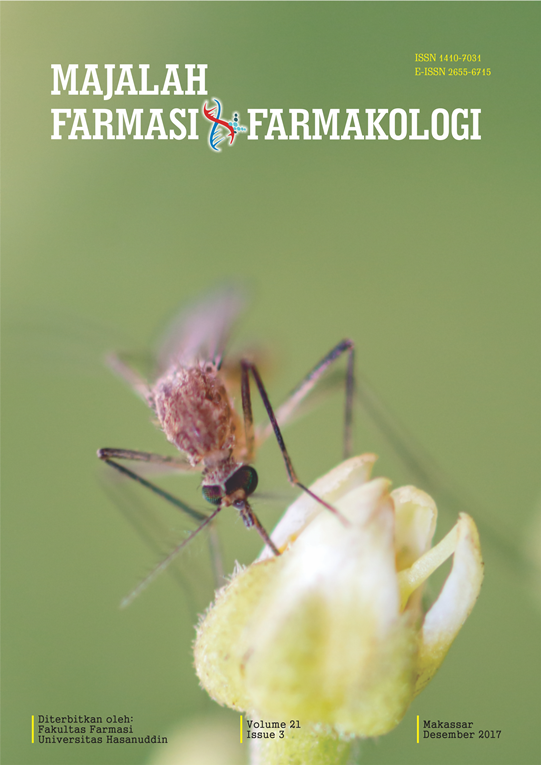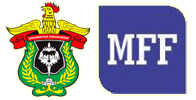EFEKTIVITAS PENGGUNAAN MgSO4 SEBAGAI TOKOLITIK PADA ANCAMAN PERSALINAN PREMATUR DI RSUP DR. WAHIDIN SUDIROHUSODO
Abstract
Penelitian ini dilakukan di Rumah Sakit Dr. Wahidin Sudirohusodo Makassar. Rumah Sakit Umum Daerah Labuang Baji, RSIA Sitti Khadijah, dan Klinik Sitti Khadijah Makassar dari Mei hingga Juli 2017 bertujuan menguji efektifitas penggunaan obat MgSO4 sebagai tokolitik pada pasien dengan ancaman persalinan prematur di Makassar. Terdapat 32 pasien yang terdaftar dalam penelitian. Jenis penelitian ini merupakan penelitian observasional dengan mengikuti rancangan deskriptif analitik dan pengambilan data secara prospektif. Hasil penelitian ini adalah dari 32 pasien yang mendapat terapi MgSO4, 2 orang yang berhasil menunda persalinan prematur dalam waktu 2x24 jam pada pemberian terapi ke 2 tanpa kontraksi, 21 pasien yang berhasil menunda persalinan prematur dalam waktu 2x24 jam pada pemberian terapi ke 3 tanpa kontraksi, 6 pasien yang berhasil menunda persalinan dengan penurunan kontraksi tersisa 1x10 menit (15-20 detik) dan 5 pasien yang berhasil menunda persalinan dengan penurunan kontraksi tersisa 1x10 menit (10-15 detik) masing-masing pada pemberian terapi ke 3. Dari hasil tersebut dapat disimpulkan bahwa, efektifitas MgSO4 dalam menunda persalinan prematur dalam waktu 2x24 jam adalah sebesar 71.87%.
References
Claas, M.J., Bruinse, H.W., Van der Heide-Jalving, M., Termote, J., de Vries, L.S., 2010, Changes in survival and neonatal morbidity in infants with a birthweight of 750g or less. Neonatology. (98); pp. 278–88
Kugelman, A., Bader, D., Lerner-Geva, L., et al, 2012, Poor outcomes at discharge among extremely premature infants: a national population-based study. Archives of Pediatrics & Adolescent Medicine. (6); 543–50
Boyle, E., Poulsen, G., Field, D., Kurinczuk, et al, 2012, Effects of gestational age at birth on health outcomes at 3 and 5 years of age: Population based cohort. BMJ. (344); e896.
World Health Organization, 2015, On interventions to improve preterm birth outcomes. WHO Press. France. p1-98.
Muglia, L., Michael, K., 2010, The enigma of spontaneous preterm birth. NEJM. (362); pp.529-35.
Yulifah, Yuswanto, 2009, Asuhan Kebidanan Komunitas, Salemba Medika, Jakarta. Hal.16-17.
Agustin, C., Romero, R., Pedro, J., 2011, Nifedipine for The Management of Preterm Labor. Am J Obstet Gynecol. Department of Obstetrics and Gynecology. Wayne State University, Detroit, MI.
Krisnadi, S.R., 2009, Faktor Risiko Persalinan Prematur. Refika Aditama. Bandung.
Ip, M., Peyman, E., Lohsoonthorn, V., Williams, M.A., 2010, A Case Control Study of Preterm Delivery Risk Factors According to Clinical Subtypes and Severity. J.Obstet.Gynaecol Res. 36(1); pp.1-16
Kartikasari, R.I., 2010, Hubungan Faktor Risiko Multiparitas Dengan Persalinan Preterm Di RSUD Dr. Soegiri Lamongan [serial on the internet], [cited 2017 july 27]; 1: [about 46 screens]. Available from : http://eprints.uns.ac.id/10350/1/154252108201011441.pdf
Agustiana, T., 2012, Faktor Faktor Yang Berhubungan Dengan Persalinan Prematur di Indonesia Tahun 2010 (Analisis RISKERDAS 2010). [serial on the internet], [cited 2017 juli 27]; 1: [about 127 screens]. Available from : http://lib.ui.ac.id/file?file=digital/20302750-S-Tria%20Agustiana.pdf
Suspimantari, C., Pramono, Besari, A., 2014, Faktor Risiko Prematuritas Yang Berpengaruh Terhadap Luaran Maternal Dan Perinatal Berdasarkan Usia Kehamilan Studi Kasus Di Rsup Dr. Kariadi Semarang Tahun 2013. Tesis FK UNDIP. Semarang.
Sulistiarini, D., 2016, Faktor - Faktor Yang Memengaruhi Kelahiran Prematur Di Indonesia: Analisis Data Riskesdas 2013. [serial on the internet], [cited 2017 july 27]; 1 [about 7 screens]. Available from: https://media.neliti.com/media/publications/36815-ID-faktor-faktor-yang-memengaruhi-kelahiran-prematur-di-indonesia-analisis-data-ris.pdf
Oroh, S, 2015, Karakteristik Persalinan Prematur Di Rsup Prof. Dr. R. D. Kandou Manado. [serial on the internet], [cited 2017 july 27]; 1: [about 3 screens]. Available from: https://ejournal.unsrat.ac.id/index.php/eclinic/article/view/8605/8178
Kawagoe, Y., Sameshima, H., Ikenoue, T., 2010, Magnesium Sulfate as a Second-Line Tocolytic Agent for Preterm Labor: A Randomized Controlled Trial in Kyushu Island. Department of Obstetrics and Gynecology, National Hospital Organization Nagasaki Medical Center. Japan, [cited 2017 February 20]. Available from: https://www.hindawi.com/journals/jp/2011/965060/
Gde, T.A., 2014, Perbandingan Antara MgSO4 Dan Nifedipin Sebagai Tokolitik Pada Preterm Labor. [serial on the internet], [cited 2017 Juni 2]; 1 : [about 32 screens] Available from : https://fk.unud.ac.id/obgin/wp-content/uploads/2015/04/Perbandingan_Antara_MgSO4_dan_Nifedipin_sebagai_Tokolitik_pada_Preterm_Labor.pdf
Downloads
Published
Issue
Section
License
The copyright to this article is transferred to Universitas Hasanuddin (UNHAS) if and when the article is accepted for publication. The undersigned hereby transfers all rights in and to the paper including without limitation all copyrights to UNHAS. The undersigned hereby represents and warrants that the paper is original and that he/she is the author of the paper, except for material that is clearly identified as to its original source, with permission notices from the copyright owners where required. The undersigned represents that he/she has the power and authority to make and execute this assignment.
We declare that:
- This paper has not been published in the same form elsewhere.
- It will not be submitted anywhere else for publication prior to acceptance/rejection by this Journal.
- A copyright permission is obtained for materials published elsewhere and which require this permission for reproduction.
Furthermore, I/We hereby transfer the unlimited rights of publication of the above-mentioned paper in whole to UNHAS The copyright transfer covers the exclusive right to reproduce and distribute the article, including reprints, translations, photographic reproductions, microform, electronic form (offline, online) or any other reproductions of similar nature.
The corresponding author signs for and accepts responsibility for releasing this material on behalf of any and all co-authors. This agreement is to be signed by at least one of the authors who have obtained the assent of the co-author(s) where applicable. After submission of this agreement signed by the corresponding author, changes of authorship or in the order of the authors listed will not be accepted.


